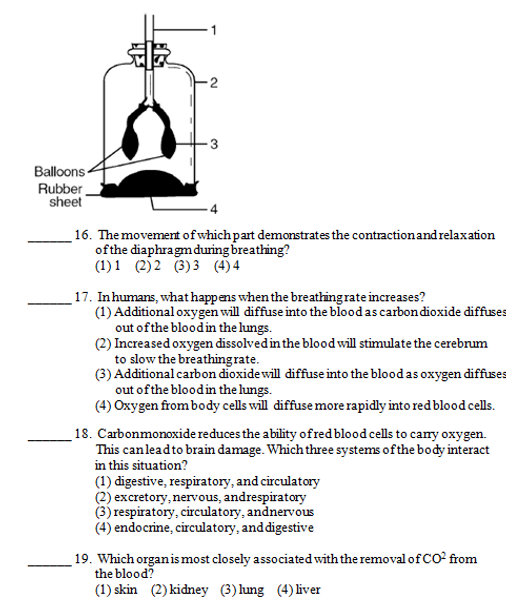Description
This zip file contains the activities listed below which may be used to compose a unit on human respiration. All pdf files are accompanied by editable word files to suit individual teacher and classroom needs. This product contains 16 pages of resources including scaffolded notes with supporting PowerPoint, a worksheet, a quiz and a brief lab activity requiring no special materials. These documents are well suited for use in distance learning environments.
- Human Respiration Scaffolded Completion Notes (4 pp.)
- PowerPoint to accompany the Human Respiration Scaffolded Completion Notes (13 slides)
- Human Respiration Review Sheet (30 multiple choice, completion, diagram and multi-part short answer questions) (6 pp.)
- Human Respiration Quiz (25 multiple choice questions) (4 pp.)
- Exercise and Respiration Rate Activity (2 pp.)
- Marzano Learning Goals
- NGSS, Common Core with learning goals (2 pp.)
Human Respiration Learning Goals
Upon completion of this unit the student will:
1. correctly state the respiratory function(s) of the following human respiratory structures; nostrils, nasal passages, pharynx, glottis, epiglottis, larynx, trachea, bronchi, bronchioles, alveoli (lung), and the diaphragm.
2. given a human respiration diagram, correctly label the structures listed in objective number one.
3. explain how gases are exchanged between the alveoli and capillaries surrounding them.
4. explain the mechanical process of breathing.
5. discuss the chief symptom(s) of the following respiratory disorders; pneumonia, asthma, and emphysema.
6. recognize that all organisms must have a thin, moist membrane for the respiratory exchange of gases.
7. describe the feedback mechanism which regulates human respiratory rate through our medulla.
NGSS Standard
HS-LS1-2. Develop and use a model to illustrate the hierarchical organization of interacting systems that provide specific functions within multicellular organisms.
Common Core State Standards Connections:
ELA/Literacy
SL.11-12.5 Make strategic use of digital media (e.g., textual, graphical, audio, visual, and interactive elements) in presentations to enhance understanding of findings, reasoning, and evidence and to add interest.
NY State Living Environment Core Curriculum
Performance Indicator 1.2
Describe and explain the structures and functions of the human body at different organizational levels (e.g., systems, tissues, cells, organelles).
Major Understandings
1.2a Important levels of organization for structure and function include organelles, cells, tissues, organs, organ systems, and whole organisms.
1.2b Humans are complex organisms. They require multiple systems for digestion, respiration, reproduction, circulation, excretion, movement, coordination, and immunity. The systems interact to perform the life functions.
1.2c The components of the human body, from organ systems to cell organelles, interact to maintain a balanced internal environment. To successfully accomplish this, organisms possess a diversity of control mechanisms that detect deviations and make corrective actions.
1.2d If there is a disruption in any human system, there may be a corresponding imbalance in homeostasis.
1.2e The organs and systems of the body help to provide all the cells with their basic needs. The cells of the body are of different kinds and are grouped in ways that enhance how they function together.
Bundle and Save!
Many more biology materials are available from Monday's Rescue. The Biology/Life Science Course contains 22 units which can be used to develop a full year course. A purchase of the Biology/Life Science Course provides significant savings of over 70% compared to purchasing each of the 22 units individually. This course is available for $24.99. It contains over 900 pages of learning materials and 1500 plus PowerPoint slides.
This year long course contains the following units:
- Life Processes and Introduction to Classification Learning Activities
- Cell Structure and Function Lesson Activities
- Membrane and Membrane Processes Learning Activities
- Introduction to Biochemistry and Enzymes Lesson Activities
- Human Nutrition Learning Activities
- Human Circulation Learning Activities
- Immunity Lesson and Lab Activities
- Human Respiration Learning Activities
- Introduction to Cell Respiration Learning Activities
- Introduction to Human Excretion and Human Locomotion Learning Activities
- Nervous and Endocrine Systems Lesson Activities
- Introduction to Mitosis and Asexual Reproduction Lesson Activities
- Introduction to Meiosis Lesson Activities
- Reproduction and Development Lesson Activities
- Plant Systems and Adaptations Lesson Activities
- Photosynthesis Learning Activities
- Plant Reproduction and Development Lesson Activities
- Classical Genetics Learning Activities (Mendelian and Beyond Mendel)
- Introduction to DNA, RNA, Protein Synthesis and Biotechnology Lesson Activities
- Introduction to Evolution Lesson Activities
- Ecology Lesson Activities
- Human Ecology Learning Activities
- Complete NY State Living Environment Regents Review Packets with Answers
View the contents of the whole year course in more detail at Biology/Life Sciences Complete Course
Terms of Use
Purchase of the product is for classroom use by the purchaser only. It is a violation for individuals, schools, and districts to redistribute or sell this item on the Internet or to other individuals. I do encourage you to use and edit these documents to suit your needs with your own students in distance learning environments.
This work is licensed under a Creative Commons Attribution-NonCommercial-ShareAlike 4.0 International License.


















